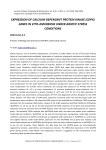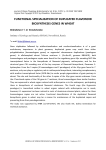Статьи журнала - Журнал стресс-физиологии и биохимии
Все статьи: 984
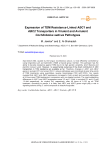
Статья научная
Spot blotch (SB), caused by the fungus Cochliobolus sativus , is most efficiently controlled by using fungicides such as triadimefon (TDM) a triazole group member. This pathogen has the ability to develop resistance against TDM due to its high genetic variability, short lifecycle and plentiful inoculum yield. However, no experimental evidences of the direct contribution of ABC transporters in TDM resistance are available so far. Therefore, changes in ABC1 and ABC2 genes in avirulent Pt1 and virulent Pt4 C. sativus pathotypes were monitored at early time points of TDM treatments using quantitative reverse transcriptase PCR (qRT-PCR). Our results revealed that ABC1 and ABC2 expressions increased in both virulent and avirulent pathotypes at 24 hours post TDM treatments in comparison with non-treated controls. The most outstanding differences in ABC1 and ABC2 expressions were 3.2 and 1.2-fold, in avirulent Pt1 and 4.2 and 1.5-fold respectively, for virulent Pt4, respectively, after 48 hours of 0.125 µg mL-1TDM treatment. According to results, it is likely that ABC1 and ABC2 genes might play a role in signaling actions during C. sativus exposure to triazole fungicides.
Бесплатно
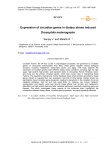
Expression of circadian genes in dietary stress induced Drosophila melanogaster
Статья обзорная
Circadian rhythm, the 24-hour cycles in physiological processes, are governed by circadian genes. In Drosophila melanogaster (fruit flies), these genes regulate various biological functions, including metabolism, sleep-wake cycles, and aging. This study explores the expression of circadian genes under different dietary stress conditions, including high fat, high sugar, high alcohol, high protein, and starvation diets. In Drosophila , Period, Timeless, Clock, and Cycle are the primary circadian genes, which play crucial roles in maintaining these rhythms. The regulatory mechanisms involve feedback loops where proteins encoded by these genes interact to regulate their own expression and that of other genes. Dietary stress can significantly impact circadian gene expression, leading to disruptions in the circadian clock and metabolic pathways. High fat and high sugar diets, for instance, can induce metabolic dysregulation and obesity, while high alcohol intake affects liver function and metabolism. Starvation and high protein diets also alter metabolic pathways, potentially impacting aging and lifespan. This study investigates these impacts at the molecular level, highlighting the intersection between dietary stress, circadian gene expression, and aging signaling pathways.
Бесплатно
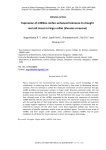
Статья научная
Plants respond to the environmental cues in various ways, recent knowledge of RNA interference in conferring stress tolerance had become a new hope of developing tolerant varieties. Here we attempt to unfold the molecular mechanism of stress tolerance through miRNA profiling and expression analysis in Finger millet (Eleusine coracona) under salt and drought stress conditions. The expression analysis of 12 stress specific conserved miRNAs was studied using semi-quantitative real time PCR and Northern blot assay. Our studies revealed that, although most of the miRNAs responded to the stresses, the expression of particular miRNA differed with the nature of stress and the tissue. The expression analysis was correlated with the existing data of their target genes. Abiotic stress up-regulated miRNAs are expected to target negative regulators of stress responses or positive regulators of processes that are inhibited by stresses. On the other hand, stress down-regulated miRNAs may repress the expression of positive regulators and/or stress up-regulated genes. Thus the current study of miRNAs and their targets under abiotic stress conditions displays miRNAs may be good candidates to attribute the stress tolerance in plants by transgenic technology.
Бесплатно

Статья научная
Rationale. This article presents a study of the stress response to the effects of water deficiency in various genotypes of Scots pine, contrasting in seed yield, breeding genotypes of silver and downy birch, hybrids of black, white poplar and intersectional poplar hybrids.
Бесплатно
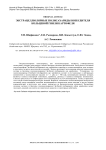
Extracellular polysaccharides of potato ring rot pathogen
Статья обзорная
Many bacteria, including phytopathogenic ones produce extracellular polysaccharides or exopolysaccharides which are universal molecules. Causal agent of potato ring rot, Clavibacter michiganensis subspecies sepedonicus, secretes exopolysaccharides which role in pathogenesis is poorly investigated. The aim of our research is to ascertain the composition and structure of Clavibacter michiganensis subspecies sepedonicus exopolysaccharides. Exopolysaccharides of Clavibacter michiganensis subspecies sepedonicus are determined to consist of 4-6 anionic and neutral components which have molecular weights from 700 kDa. Glucose is a major monomer of polysaccharides and arabinose, rhamnose and mannose are minor monomers. Glucose is present in α-D-glucopyranose and β-D-glucopyranose configurations. Calcium is determined to be a component of exopolysaccharides. Components of exopolysaccharides of potato ring rot pathogen are probably capable to associate via calcium ions and other ionic interactions that may result in a change of their physiological activity. Further studies of Clavibacter michiganensis subspecies sepedonicus exopolysaccharides composition and structure can serve a base for the synthesis of their chemical analogues with elicitor action.
Бесплатно
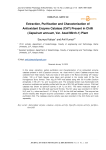
Статья научная
In this study, extraction, partial purification and characterization of an antioxidant enzyme catalase present in chilli ( Capsicum annuum , var. Azad mirch-1) plant. Catalase enzyme was collected from fresh leaves, fruits and roots of chilli plant in the Rama University UP, Kanpur (India). 100 g of fresh tissues were taken and grinded in the mortar pistil till the fine homogenous slurry formed. Then 10g of PVPP was added along with 50 ml buffer (Sodium phosphate, 0.1M, pH 7.2), and 1g ascorbic acid. The extracted protein was fractionated with ammonium sulphate and partially purified with the use of SG-150 gel filtration column. Chilli leaf catalase has shown its optimum activity in pH 7.2 at 30oC. The native molecular weight of catalase present in the chilli leaf was found 59 kDa. The Km value was recorded 9.2 mM for H2O2 and Vmax value was found 1.41 IU/mg X 10-3 for the chilli leaf catalase. The enzyme has shown linearity after 8mg/ml enzyme concentration. Chlilli catalase was purified up to 50.83 purification fold. The catalase enzyme activity was also recorded in the chilli fruits and roots separately.
Бесплатно
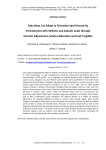
Статья научная
This study investigated the effect of shikimic and salicylic acids at the concentrations of 0.4 and 0.7 mM, respectively, or their combination as phenolic compounds and Ridomil MZ at the concentration of 250 g/100 L as a fungicide on osmotic pressure (OP), solutes allocation, organic acids, inorganic ions and relative water content were quantified in Vicia faba leaves infected by Botrytis fabae. Pathogen induced noticeable decrease in osmotic pressure, total soluble sugar (TSS) and inorganic osmolytes (i.e. Na +, K +, Ca 2+, Mg 2+ and Cl -) while caused obvious increase in proline, total soluble nitrogen (TSN) and organic acids (i.e. Keto and citric acids) in water extract of the leaf of faba bean plants. Furthermore, pathogen caused marked decrease in relative water content (RWC) of infected leaves and as a consequence the saturation water deficit (SWD) was increased. Exogenous application of shikimic acid, salicylic acid or their combination could counteract the adverse effects of B. fabae on osmotic adjustment by inducing additional increase in proline, total soluble sugars, total soluble nitrogen and organic acids which in turn increase the osmotic pressure as well as relative water content in leaves of infected plants. Recovery of osmotic adjustment as well as leaf turgidity of infected host by using these chemical inducers may encourage the using of them as protective control means. The results of the present study showed also that the application of chemical inducers such as shikimic and salicylic acids or their interaction increased the resistance of Vicia faba against the chocolate spot disease.
Бесплатно
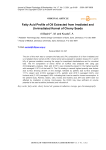
Fatty Acid Profile of Oil Extracted from Irradiated and Un-Irradiated Kernel of Cherry Seeds
Статья научная
The aim of this work was to compare the fatty acid (FA) composition of oil from irradiated and un-irradiated cherry kernels (ChK). Cherry kernel were exposed to radiation doses of 0, 3 and 6 kGy of gamma irradiation covering the range for insect/pest disinfestations and for microbial load. The FA composition of cherry kernel oil (ChKO) was analyzed with using gas chromatography analysis. Oleic acid (C18:1) was consistently present in the highest quantity with averaged 51.07% of the total FA. The FA existing in second highest quantity was linoleic acid (C18:2) showing 38.03% on the average, followed by palmitic acid (C16:0) averaged 7.71%, stearic acid (C18:0) averaged 2.41%, palmitic acid (C16:1) averaged 0.42%, and linolenic acid (C:18:3) averaged 0.38%. indicating that it can be used for human consumption. In the present study, Palmitic, stearic, oleic, linoleic and linolenic acid, SFA and USFA were not affected by irradiation or storing. Conclusively, the ChKO may have sufficient oil volume potential to be used as edible (domestic) and industrial oil.
Бесплатно
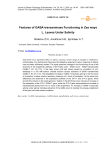
Features of GABA-transaminase functioning in Zea mays L. leaves under salinity
Статья научная
Salt stress has a significant effect on plants, causing a whole range of changes in metabolism. Unfortunately, the mechanisms that ensure the adaptive response of cells in response to salinity have not been sufficiently studied. The study examined changes in the functioning of one of the enzymes of the anaplerotic pathway of the Krebs cycle - GABA shunt - GABA transaminase (GABA-T, EC 2.6.1.19). It has been shown that salt stress caused by incubation of corn seedlings in a 150 mM sodium chloride solution causes activation of GABA transaminase (GABA-T, EC 2.6.1.19). The established increase in GABA-T enzymatic activity in the first hours of incubation in saline solution reaches a maximum at 3 hours of incubation. At the same time, differences are observed in the expression profilees of the GTA-1 and GTA-2 genes, which encode this enzyme in the maize genome. Salinity in the first three hours induces an increase in the expression of the GTA-1 GABA-T gene, while the GTA-2 gene demonstrates an increase in transcriptional activity from 6 to 12 hours of the experiment. An increase in GABA-T enzymatic activity under salinity indicates activation of the GABA shunt to maintain the energy metabolism of the plant cell under stress conditions.
Бесплатно

Статья обзорная
The interest toward natural components in treatment and prevention of several diseases such as diabetes, cancer, coronary disease, arthritis, etc. have been increased in recent years. Common thistle is an annual/biennial broad-leaf weed which is rich in insulin, a starch which passes directly through the digestive system. Its root in diuretic, tonic, antiphlogistic, astringent and hepatic in traditional medicine as well as an important remedy for toothache. Ramsons is an erect perennial native to Eurasia and the most notable pharmacological benefits of ramsons are antibacterial activity, treats stomach problems, useful for chronic disease, many benefits for blood pressure and high cholesterol, appropriate for skin, suitable for inflammations and infections, aids in detoxification, ameliorate aggravations and allergies. The outstanding pharmacological benefits of lychee is helping to remove blemishes and reduce sunburns, to prevent signs of aging, promoting hair growth and providing a distinct shine, prevention of cataracts, anticancer effects, improve digestion, promoting cardiovascular health, regulating blood circulation, anti-influenza activity, anti-inflammatory activity, preventing blood vessel rupture, strengthening bones, increasing the libido and preventing anemia. The most notable health benefits of five flavor berries are increasing energy, anti-inflammatory activity, improving muscular activity, improving vision, increasing cellular health, and preventing liver disease, premature aging and protection against diabetes, radiation, and regulation of blood glucose levels, improve mental health, modulating blood pressure, improving digestion and preventing infection. Ajwain oil has a wide range of pharmaceutical applications such as antifungal, antibacterial, antioxidant, anti-inflammatory, antibacterial, nematicidal, stomachic, carminative, antiseptic, aromatic, digestive, antiseptic, and emmenagogue activities. The present review aims to present some of the most important pharmacological and health benefits five important medicinal plants in traditional Asian medicine which can be studied more due to their valuable chemical components to prevent and treatment of diseases.
Бесплатно
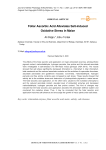
Foliar Ascorbic Acid Alleviates Salt-induced Oxidative Stress in Maize
Статья научная
The effects of the foliar ascorbic acid application on major antioxidant enzymes, photosynthetic pigment content, malondialdehyde, hydrogen peroxide, free proline and the reduced ascorbate were investigated in salt-stressed (75 mM NaCl) maize genotype (ADA 9510). The results showed that salt stress significantly decreased chlorophyll a, chlorophyll b, total chlorophyll, total carotenoid and the reduced ascorbate contents and the activities of superoxide dismutase, ascorbate peroxidase and glutathione reductase. Conversely, malondialdehyde, hydrogen peroxide and free proline contents were increased by salt stress. These results showed that salinity led to the oxidative stress and destruction of photosynthetic pigments in maize leaves. The foliar ascorbic acid application, on the other hand, caused to the increased chlorophyll a and the reduced ascorbate content, elevated level of antioxidant enzymes and decreased malondialdehyde, hydrogen peroxide and free proline content. This kind of changes may indicate that the foliar ascorbic acid application activates the antioxidant defence system and counteract the oxidative stress. Thus, it may be concluded that the foliar ascorbic acid application improves salt tolerance and encourage the growth of maize plants under salt stress.
Бесплатно
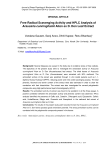
Статья научная
Background: Several diseases are caused in the body due to oxidative stress of free radicals. The objectives of the present study were to investigate the antioxidant activity of Araucaria cunninghamii Aiton ex D. Don (Araucariaceae) leaf extract. The dried leaves of Araucaria cunninghamii Aiton ex D. Don (Araucariaceae) were extracted with 80% methanol. The antioxidant activity of the extract was predicted through in vitro model systems such as 1,1-diphenyl-2-picryl hydrazyl (DPPH), reducing power and nitric oxide scavenging assays. The total phenolic, flavonoid and tannin content of the extract were also estimated in order to draw the correlation with their bioactivities. The extract was also investigated for several polyphenolic compounds using High-performance liquid chromatography (HPLC). Results: The antioxidant activity of extract was found to be excellent in all the three assays. A positive correlation between the antioxidant activity and phenolic content was observed. HPLC analysis identified the presence of Gallic acid, Catechin, Chlorogenic acid, Epicatechin, Caffeic acid, Umbelliferone, Ellagic acid, Quercetin and Kaempferol in the methanol leaf extract of Araucaria cunninghamii Aiton ex D. Don. Conclusions: The results of the present study point towards the fact that Araucaria cunninghamii Aiton ex D. Don leaves possess good antioxidant potential. The strong antioxidant activity can be correlated with the polyphenolic compounds present in the leaves.
Бесплатно
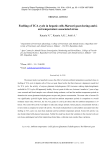
Fuelling of TCA cycle in hepatic cells Marwari goat during ambient temperature associated stress
Статья научная
The present study was launched to assess the effect of extreme ambient temperature associated stress on fuelling of TCA cycle in hepatic cells of Marwari goat. Based on the fact that whenever a hepatocyte needs fuel for TCA cycle, the activity of enzyme glutamate dehydrogenase (GD) increases making alpha-ketoglutarate available for TCA cycle, 600 apparently healthy Marwari goats of either sex, between 6 months to 3 years of age were screened and blood samples were collected during moderate, cold and hot ambient temperature periods to determine the serum glutamate dehydrogenase enzyme and glucose concentration. The mean value of serum GD was significantly (p≤0.05) higher during cold and hot ambient temperature periods in comparison to overall moderate mean value. However, the rise was greater in cold (2.20 times) than hot ambient temperature (1.19 times). The serum GD activity was higher in male and younger animals. Serum glucose concentration showed a reverse trend as compared to serum GD activity. The results indicated that in cold condition associated stress the fuelling to TCA cycle was more than moderate and hot ambient temperature periods. Serum GD activity was also found related with glucose homeostasis. Further the study has shown that variations in the enzyme levels are not always pathological and while interpreting clinical data, a clinician must consider these variations.
Бесплатно
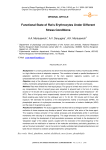
Functional state of rat’s erythrocytes under different stress conditions
Статья научная
Background: In our early publications was shown that electrophorhetic motility of erythrocytes (EPME) is a high effective criteria of adaptation response. This correlation is based on parallel development of adaptation syndrome and activation of the main organism regulatory systems, such as sympatoadrenalic and hypotalamo-hypophosial-adrenal ones. Objective: study of the influence of physical exercises and adrenaline injections on electrophorhetic motility, membrahes phospholipids spectrum and oxidative metabolism of the rats’ erythrocytes. Methods: Rats were divided into three equal groups. First group of animals was control (n=10; without any manipulations). Rats of second group were subjected to physical load in the form of a sailing duration of 15 minutes with a cargo amounting to 10% of animal body weight (water temperature - 26-280C). Rats of third group were intraperitoneally injected with adrenaline hydrochloride (0.1 mg/kg). Blood sampling was made from the sublingual vein in 15, 30, 60, 120 minutes and 24 hours after exposure. We estimated the dynamics of the electrophorhetic motility of erythrocytes (EPME), the phospholipid spectrum of erythrocytes membranes, the concentration of malonic dialdehyde (MDA) and the state of the glutathione system. Results and conclusions: The study suggests that red blood cell as a biological system is capable for realization of stress response may develop a special “alarm reaction” after action of the stress agent. This response initiates activation of free radical processes and phospholipids profile in erythrocyte membranes with reducing of its electronegativity. This stage enhances the activity of the antioxidant system, is limiting the development of lipid peroxidation processes, and leads to the development of "adaptation stage" of the cellular system, coupled with the restoration of the electronegativity of the membrane and the mobilization of reserves of low molecular antioxidants, particularly glutathione, as well as "structural antioxidant", due to the content of readily oxidizable lipid (phosphoethanolamine) and lipids that are resistant to oxidation (phosphatidylcholine, sphingomyeline).
Бесплатно
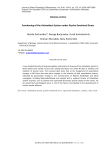
Functioning of the antioxidant system under psycho-emotional stress
Статья научная
It was studied intensity of lipid peroxidation and activity of enzymes from antioxidant system in blood plasma and cardiac muscle cells among laboratory rats under 40 days of isolation and violation of diurnal cycle. The received data show that at the background of quantitative changes in NO there also take place changes in the intensity of lipid peroxidation process, indicated by quantitative change in the concentration of Malone dialdehyde and diene conjugates, including Malonedialdehyde and marked with a reduced activity of antioxidant system enzymes, such as catalase and superoxide dismutase activity. Based on the results, we pro-posed that psychological stress is one of the factors contributing to the development of various cardiac diseases.
Бесплатно
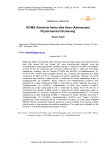
GC/MS Artemisia herba alba Asso (Asteraceae) phytochemical screening
Статья научная
Methanolic (Meth) and ethanolic (Eth) Artemisia herba-alba Asso aerial parts extract including buds (AB), leaves (AL) and flowers (AF) were phytochemicaly analyzed using gas chromatography-mass spectrometry (GC/MS) analysis. A. herba-alba GC/MS chromatogram showed 16 and 39 compounds were occurred in Meth and Eth A. herba-alba AB extract, respectively, revealing that the Thujone (37.026% and 49.022%), 9-Octadecanamide, (Z)- (15.471% and 11.479%) and Eucalyptol (10.057% and 10.083%) were presented as a major compounds for Meth and Eth A. herba-alba AB extract, respectively. Whereas, 24 and 20 compounds were occurred in Meth and Eth A. herba-alba AL extract, respectively; where, 9-Octadecanamide, (Z)- (28.687%), Phytol (12.611%) and Palmitoleamide (12.304%) were presented as a major compounds for Meth A. herba-alba AL extract. Whereas, they were 9-Octadecanamide, (Z)- (25.687%), Dodecanamide (16.142%) and Camphor (14.494%) presented as a major compounds for Eth A. herba-alba AL extract. As for AF, 28 and 14 compounds were occurred in Meth and Eth A. herba-alba AF extract, respectively; where, 9-Octadecanamide, (Z)- (25.623%), Eucalyptol (11.879%) and Hexadecanamide (10.771%) were presented as a major compounds for Meth A. herba-alba AF extract. Whereas, they were 9-Octadecanamide, (Z)- (23.295%), Hexadecanamide (16.452%) and Thujone (13.144%) presented as a major compounds for Eth A. herba-alba AF extract. The current study highlights different bioactive compounds make this species as a good candidate to be used as a cheap natural source in pharmacology and medicine applications. The current study highlights for the first time A. herba-alba phytochemical analysis in Syria.
Бесплатно
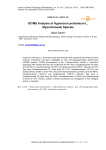
GC/MS analysis of Hypericum perforatum L. (Hypericaceae) species
Статья научная
Hypericum perforatum L. aerial parts have been extracted with tetrahydrofuran solvent and their chemical composition has been investigated by Gas Chromatography-Mass Spectrometry (GC/MS) analysis. GC/MS chromatogram of the 4 tetrahydrofuran studied H. perforatum genotypes (HP) revealed that the main constituents for HP1 were: 9-Octadecenamide (Z)-(Oleic acid) (65.551%), Hexadecenamide (20.681%) and Dodecenamide (5.595%). Whereas, for HP2, they were 9-Octadecenamide (Z)- (Oleic acid) (63.117%), Hexadecenamide (19.107%) and Dodecenamide (5.585%). As for HP3, they were 9-Octadecenamide (Z)-(Oleic acid) (63.496%), Hexadecenamide (18.891%) and Dodecenamide (5.961%). Whereas, they were 9-Octadecenamide (Z)-(Oleic acid) (62.048%), Hexadecenamide (19.325%) and Dodecenamide (5.914%) for HP4. Thereby, isolation of these constituents and investigation of their biological activity is requested.
Бесплатно
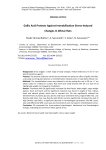
Gallic acid protects against immobilization stress-induced changes in Wistar rats
Статья научная
Background: Stress triggers a wide range of body changes. Herbal medicines are rich in non specific antistress agents. Purpose: The present study was carried out to evaluate the antistress effect of gallic acid (GA), a naturally occurring plant phenol, on immobilization induced-stress in male albino Wistar rats. Methods: The immobilization stress was induced in rats by putting the rats in 20 cm × 7 cm plastic tubes for 2 h/day for 21 days. Rats were post orally treated with GA at a dose of 10 mg/kg body weight via intragastric intubations. Results: Treatment with GA significantly increased the food intake, body weight, organ weight (spleen, testis and brain) and the significant reduction was found in weight of liver, kidney, heart and adrenal glands, which was increased in stressed rats. GA also significantly reduced the elevated levels of plasma glucose, plasma and tissue cholesterol (CHL), triglycerides (TG), Low Density Lipid (LDL), Very Low Density Lipid (VLDL) and also significantly increased the level of High Density Lipid (HDL). A significant decrease in hematological parameters like RBC count, total and differential WBC count was also found which were increased in immobilization stress. Conclusion: GA prevented the stress-induced physiological, biochemical and hematological changes, indicating the preventive effect against stress.
Бесплатно

